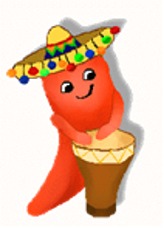 |
|
||||||||














EDUC 475/698A
|
|||||||||||||||||||||||
Spanish 101Created by: Neda Mihneva and Veronika Subertova |
 |
| Instructional
Objective | Learners & Context |
Object of Game | Game
Materials | |
|
Instructional ObjectiveThe main purpose of this game is to create a fun way of learning and memorizing Spanish vocabulary. Not only will linguistic skill being challenged, but also the fastest path will need to be determined in order to reach the top fastest. |
|
Learners & Context of UseThis game is designed for the beginners in Spanish language studies. |
|
Object of the GameFinding the fastest path to reach the top of the pyramid while learning new Spanish vocabulary. |
|
Game Materials
|
|
Time RequiredThis game is for 2-4 players and it should be played for thirty minutes to an hour depending on how fast will the players find the fastest path. |
|
The RulesGame Play:
|
|
Design ProcessThe game board is arranged in squares that are built to form a pyramid. There will be 27 squares each of blue, green, yellow and red. Also, players have the chance to stop at 14 white colored squares and take a risk at 14 black squares. The player would also have to keep in mind that he has limited amount of squares to use so they have to find the most efficient path towards the top. The main concern while creating game was the size issue and difficulty of task. At first we were thinking about a bigger structure and multiple-choice questions. Considering that there is a limited amount of time a player can maintain interest while playing games, we decided for a medium size structure that should take about 30 minutes to play. The subject matter and search for the best approach for an educational game was another main concern while creating this game. The players can simply help each other out by trying to find the correct answer among each other and learn from each other. The main purpose of this game is not a stressful competition, but trying to find a fun way to learn and memorize foreign language words. The process of memorization is already stressful enough so we would like to find a way to help students increase their learning productivity while having fun by playing this game. We have learned that cooperation among group members is very helpful to enrich individual ideas and find the best way to approach the main goal of the project. Every member of the group is an individual who increases the value of the project by his or her own ideas. By creating this game we were trying to find the best way for the players to develop their learning skill and also we have developed our ability to find alternative procedures, which will eventually be helpful for each one of us. . |
|
References
|
|
| College of Education University of Maryland Benjamin Building College Park, MD 20742 http://www.edtechpolicy.org dpruitt@umd.edu |
 |
Copyright
© 2004 College of Education University of Maryland, College Park http://www.education.umd.edu |

